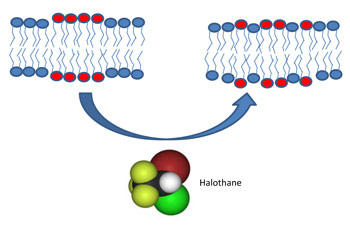
Different lipid molecules in the cell membrane separate out into an ordered region (red) and surrounding disordered regions (blue). Inhalation anesthetic molecules such as halothane cause these lipid regions to mix, potentially affecting the function of ion channel proteins found imbedded in the membrane.
Why does inhaling anesthetics cause unconsciousness? New insights into this century-and-a-half-old question may spring from research performed at the National Institute of Standards and Technology (NIST). Scientists from NIST and the National Institutes of Health have found hints that anesthesia may affect the organization of fat molecules, or lipids, in a cell's outer membrane—potentially altering the ability to send signals along nerve cell membranes.
"A better fundamental understanding of inhaled anesthetics could allow us to design better ones with fewer side effects," says Hirsh Nanda, a scientist at the NIST Center for Neutron Research (NCNR). "How these chemicals work in the body is a scientific mystery that stretches back to the Civil War."
At the turn of the 20th century, doctors suspected inhaled anesthetics had some effect on cell membranes, an animal cell's outer boundary. Despite considerable investigation, however, no one was able to demonstrate that anesthetics produced changes in the physical properties of membranes large enough to cause anesthesia. But eventually, understanding of membrane function grew more refined as scientists learned more about ion channels.
Ion channels—large proteins embedded in the relatively small lipid molecules forming the membrane—are responsible for conducting electrical impulses along nerve cells in the brain and throughout our body. By a few decades ago, the prevailing theory held that inhaled anesthetics directly interacted with these protein channels, affecting their behavior in some fashion. But no one could find a single type of ion channel that reacted to anesthetics in a way pivotal enough to settle the matter, and the question remained open.
"That's where we picked up the thread," says Nanda. "We had been looking at how different types of lipid molecules affect ion channels."
While a cell membrane is a highly fluid film made of many different kinds of lipid molecules, the region immediately surrounding an ion channel often consists of a single type of lipids that form a sort of "raft" that is more ordered and less fluid then the rest of the membrane. When the team heard other researchers had found that disrupting these lipid rafts could affect a channel's function, they put to work their own previous experience working with the channels.
"We decided to test whether inhaled anesthetics could have an effect on rafts in model cell membranes," Nanda says. "No one had thought to ask the question before."
Using the NCNR's neutron and X-ray diffraction devices as their microscope, the team explored how a model cell membrane responded to two chemicals—inhaled anesthetic, and another that has many of the same chemical properties as anesthetic but does not cause unconsciousness. Their finding showed a distinct difference in the way the lipid rafts responded: Exposing the membranes to an anesthetic caused the rafts to grow disorderly, freely mixing its lipids with the surrounding membrane, but the second chemical had a dramatically smaller effect.
While Nanda says the discovery does not answer the question definitively, he and his co-authors are following up with other experiments that could clarify the issue. "We feel the discovery has opened up an entirely new line of inquiry into this very old puzzle," he says.
M. Weinrich, H. Nanda, D.L. Worcester, C.F. Majkrzak, B.B. Maranville and S.M. Bezrukov. Halothane changes the domain structure of a binary lipid membrane. Langmuir, Feb. 21, 2012. DOI: dx.doi.org/10.1021/la204317k.

